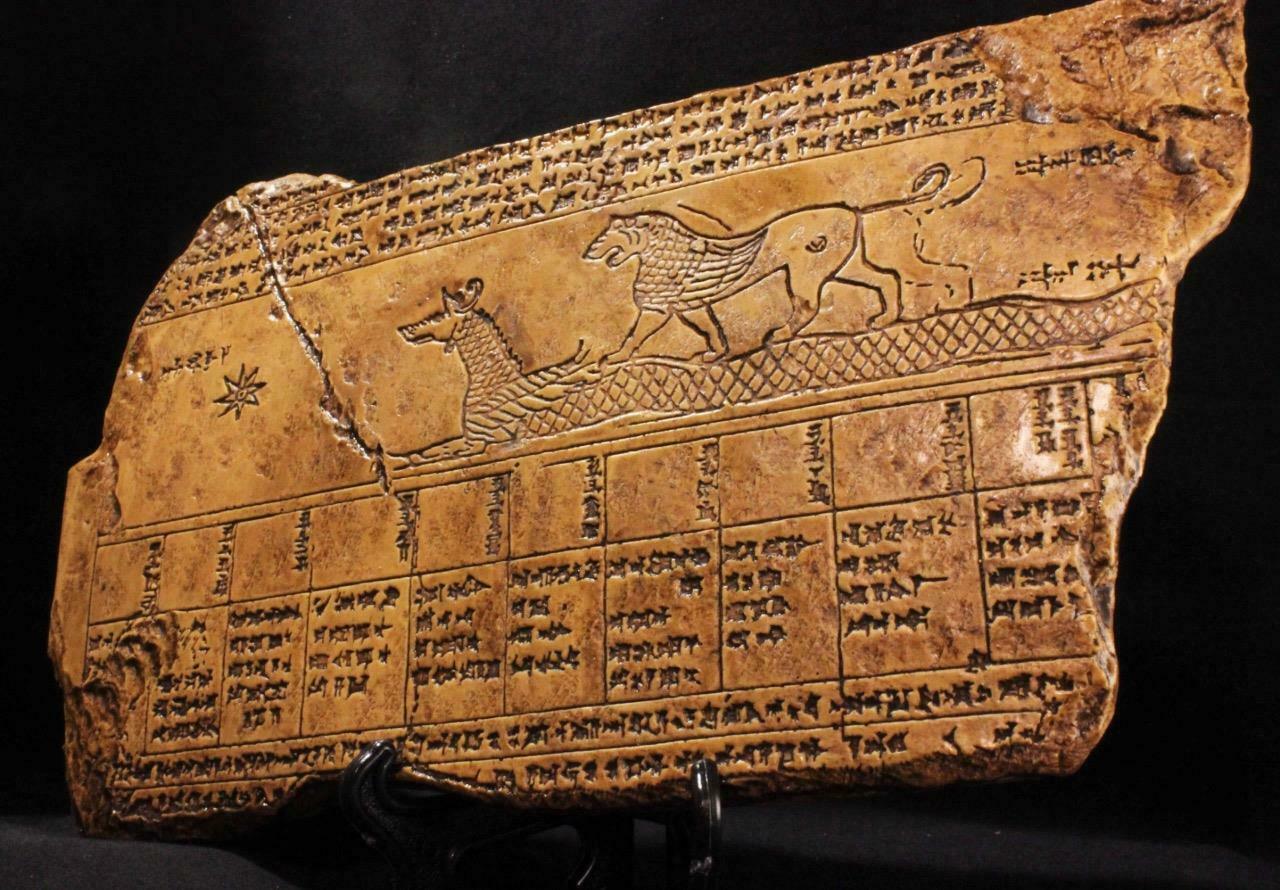-40%
Babylonian Cuneiform ALMANAC TABLET of ZODIACAL AGES #1 ancient replica
$ 30.88
- Description
- Size Guide
Description
ASTRONOMICAL ALMANAC GREEK SELEUCID ERA circa 300 BC Stone tablet, quartzite-limestone composite, approx 9 x 5.5 inches (23 x 13 cm), half inch thickness, with display stand, back-label I.D. & description sheet. Reproduction Berlin Museum Seleucid Era astronomical tablet recovered in 1912 from the ruins of the old Temple Library of Anu in ancient Uruk (Iraq), dated to 200 BC. The Seleucid Zodiac was originally a set of 12 tablets covering the 12 zodiacal periods of human history, the Great Cycle of equinox precession. This one was excavated reasonably intact from the site of an ancient library rubbish dump adjacent to the Temple of Anu in Uruk. Dated to 200 BC, the tablet belongs to the Seleucid Era (330-180 BC.) Old Sumerian star names and very ancient star positions reveal it is a "scribal copy" of a Sumerian astronomy tablet from a much earlier period. The list of zodiacal constellations begins with Leo the Lion, commencing around 11,000 B.C, a period of dramatic astronomical perturbations known in myth as the "War of the Gods." The tablet depicts a lion standing on the back of the famous Sumerian Tiamat Serpent, central characters in the well-known Babylonian Enuma Elish epic. The image of a large star is labelled Dingir-Sag-Me-Gar or "Jupiter." The tablet has since been matched with another found in the Louvre Museum. Together they provide a complete astrological calendar which depicts 12 divisions corresponding to the months and the signs of the zodiac, as well as describing lunar eclipses and unusual heavenly events. ...................................................... SELEUCID PERIOD The Persians ruled Babylonia from about 600 BC, until Alexander conquered the area in 330 BC. Upon Alexander’s death, Seleucid one of his top generals, seized control and began to Hellenize the region. This became known as the "Seleucid Period" and like the Romans after them, they reset the calendar to zero and proudly pronounced a new era. During this period, the old scribal schools continued to flourish, collecting and copying valuable ancient texts while teaching the newcomers the basics of mathematics and astronomy. .....................................................Cuneiform Astronomical Text
Cuneiform Astronomical Text
Click images to enlarge
Description
ASTRONOMICAL ALMANAC
GREEK SELEUCID ERA
circa 200 BC
ancient replica
Large brown ochre stone tablet, quartzite-limestone composite, approx 9 x 5.5 inches (23 x 13 cm), half inch thickness, with display stand, back-label & description sheet.
Reproduction Berlin Museum Seleucid Era astronomical tablet (VAT 7847) recovered in 1912 from the ruins of the old Temple Library of Anu in ancient Uruk (Iraq), dated to 200 BC.
The
Seleucid Zodiac
was originally a set of 12 tablets covering the 12 zodiacal periods of human history, the
Great Cycle
of equinox precession. This tablet was excavated reasonably intact from the site of an ancient library rubbish dump adjacent to the
Temple of Anu
in
Uruk
. Dated to 200 BC, the tablet belongs to the Seleucid Era (330-180 BC.) Old Sumerian star names and very ancient star positions reveal it is a scribal copy of a sophisticated Sumerian astronomy tablet from a much earlier period.
The list of zodiacal constellations begins with the era of
Leo the Lion,
commencing around 11,000 B.C, a period of dramatic astronomical perturbations remembered in myth as the
"War of the Gods."
The tablet depicts a lion standing on the back of the famous Sumerian
Tiamat Serpent,
central characters in the well-known Babylonian Enuma Elish epic. A large star considered to be central to the stellar perturbations is singled out and named:
Dingir-Sag-Me-Gar
or
Jupiter
.
The tablet has since been matched with another found in the Louvre Museum.
(Tablet pair is pictured below at end of photo sequence.)
Together they provide a complete astrological calendar which depicts 12 divisions corresponding to the months and the signs of the zodiac, as well as describing lunar eclipses and unusual heavenly events.
......................................................
BACKGROUND --- SELEUCID PERIOD
The Persians ruled Babylonia from about 600 BC, until Alexander conquered the area in 330 BC. Upon Alexander’s death, Seleucid one of his top generals, seized control and began to Hellenize the region. This became known as the "Seleucid Period" and like the Romans after them, they reset the calendar to zero and proudly pronounced a new era. During this period, the old scribal schools continued to flourish, collecting and copying valuable ancient texts while teaching the newcomers the basics of mathematics and astronomy.
.....................................................
Payment
CREDIT CARD or SAFE & SECURE PAYPAL
Shipping
PARCELS SENT VIA
PROTECTED POSTAGE WITH TRACKING
WELL PACKED IN BOXES TO ENSURE SAFE DELIVERY
POSTED WITHIN A DAY OF PURCHASE
(holidays & weekends don't count)
INTERNATIONAL
Transit Time
currently
10 to 15 days
Local Delivery
(Australia)
3 to 4 days
Express 2 days
COMBINED POSTAGE for multiple items
NOTE:
YOUR
POSTAL ADDRESS
MUST MATCH YOUR PAYPAL ADDRESS.
If you wish to change address, you need to adjust it in PayPal before making payment.
Terms of Sale
FULL REFUND
IF ITEM HAPPENS TO BE DAMAGED IN TRANSIT, DEFECTIVE IN SOME WAY OR YOU HAVE GOOD REASON TO BE UNHAPPY WITH IT.
About Us
SELLING ON EBAY SINCE 2007
ANCIENT IMPRESSIONS produce a number of interesting & unusual ancient artifact replicas, as well as supplying a few hard-to-get items from other sources. The majority of our replicas are handmade, cast in a non-toxic stone composite material which is harder, more durable and realistic than plaster or plastic. Items are hand finished and individually checked for quality control.
Enquiries always welcome.
Contact Us
CONTACT by clicking on link at top right of page
Pictures sell!
Auctiva offers Free Image Hosting and Editing.
300+
Listing Templates!
Auctiva gets you noticed!
The complete eBay Selling Solution.
Track Page Views With
Auctiva's FREE Counter
















